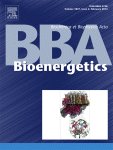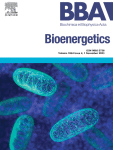7.2. The `red' chlorophylls
In photosystem I there are chlorophylls which absorb at longer wavelength than P700 (so called `long wavelength' or `red' chlorophylls). Their number varies among different organisms [153,157,158].
PS I from S. elongatus contains nine to 11 Chla per monomer which absorb light at longer wavelengths (`red shifted') than the bulk of antenna Chla [157].
Two functional roles have been discussed for the `red' chlorophylls:
facilitation of efficient light energy capture under extreme environmental conditions, and focussing of the excitation energy to the reaction centre [113].
The red shift can be caused by several types of molecular interactions or properties of the chlorophylls: excitonic interaction of cofactors [159], deviations from planarity of the chlorine ring [160], charge effects [161], electronic interactions with polypeptide side chains, and changes in the dielectric constant of the local environment of the absorbing cofactors [162]. The structure at 2.5 As resolution can not provide the final answer to the question of where the 'red' chlorophylls are located.
However, tightly interacting chlorophylls, forming dimers and trimers of chlorophyll molecules, can be identifed. These chlorophylls, which are most probably excitonically coupled, are possible candidates for some of the long wavelength chlorophylls. In the following, the discussion will focus on a unique Chl trimer and three Chl dimers located at prominent positions in the complex. On the lumenal side of the membrane close to PsaX, a Chla trimer formed by aC-B31, aC-B32 and aC-B33 is located. The arrangement of the three Chla can be best described as a staircase, where the pigment molecules can be seen to be related to each other by an approximate translation, with their ring planes oriented roughly parallel (Fig. 9).
The interplanar separations between the chlorophylls are in the range from 3.5 to 3.7 As, with lateral centre to centre shifts of 8.3 As. Strong excitonic coupling is implied by this geometry of approximate translational symmetry, because the transition dipole moments of the chlorine rings are roughly parallel. PsaB coordinates only one of these three chlorophylls, aC-B31, directly via HisB470, whereas the Mg2‡ ions of the other two Chla molecules, aC-B32 and aC-B33, are coordinated to water molecules. It is remarkable, that the topography of this chlorophyll trimer is similar to small molecule crystal structures of chlorophyll derivatives [163], showing an absorption maximum at 740 nm within the crystals. For these chlorophyll derivatives, the extreme red shift compared to solutions was explained by strong excitonic interactions supported by interactions within the stacks. Only one Chla trimer is observed in the structure of PS I from S. elongatus. The cause of the lack of a chlorophyll trimer in PsaA at a position related by the pseudo-C2 axis could be an interference of the hypothetical PsaA counterpart with the monomermonomer contact within the trimer. Aî At the lumenal side of the membrane at the interface between PS I monomers, one pair consisting of chlorophylls aC-A32 and aC-B7 is located. These two chlorophylls are coloured red in Fig. 9. They are separated by a centre to centre distance of 8.9 and an interplanar distance of 3.5 Aî. Hydrophobic contacts are observed between this pair of chlorophylls and the C-terminal region of PsaL from the adjacent monomer. In 1998, Palsson et al. detected a loss of two chlorophylls absorbing at 719 nm, when the trimer of S. elongatus was split into monomers [157]. Possibly, these two chlorophylls could be identical with the chlorophyll pair aC-A32/aC-B7. These chlorophylls could also play a role in excitation energy transfer between the monomers. Two further Chla dimers are located at prominent positions near the stromal side of the membrane, which are related to each other by the pseudo-C2 symmetry. One dimer is constituted by aC-A38 and aC-A39, coordinated to PsaA, the other consists of ac-B37 and aC-B38 coordinated to PsaB. The dimer aC-A38/aC-A39 is located close to PsaF, aC-B37/aCB38 close to PsaL. In contrast to the majority of the bulk chlorophylls, their chlorine head groups are oriented parallel to the membrane. The centre to centre distances within the pairs aC-A38/aC-A39 and aCB37/aC-B38 are 8.2 Aî and 7.6 Aî, respectively. Their ring systems are stacked at 3.5 Aî separation so that their electron systems overlap partially. In close proximity to each of the two Chla pairs, one of the `connecting' Chla is located; the centre to centre distances between aC-A38/aC-A39 and aC-A40 and aCB37/aC-B38 and aC-B39 are about 16 Aî. Based on geometrical considerations, we can speculate that the excitation energy transfer from these Chla dimers to the ETC can be achieved at reasonable rates via the two `connecting' chlorophylls, thereby suggesting that these two dimers as well as the `connecting' chlorophylls may play a special role in excitation energy transfer.















